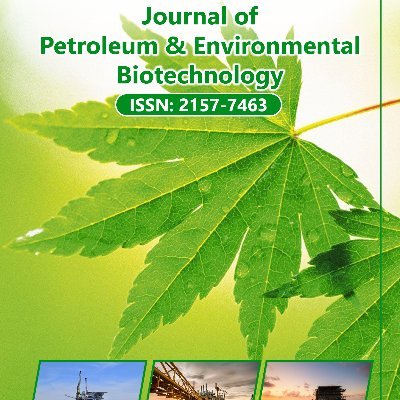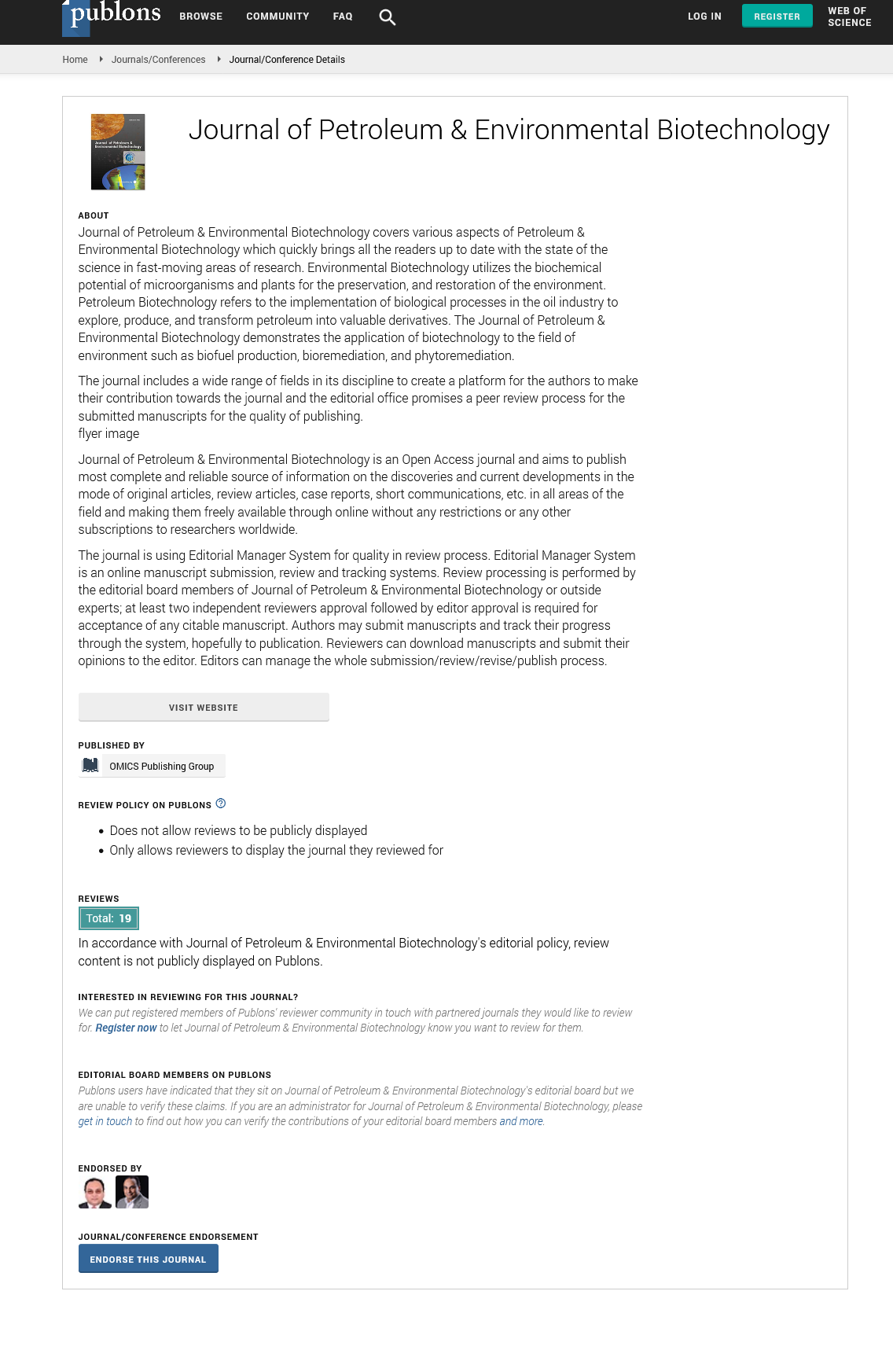Indexed In
- Open J Gate
- Genamics JournalSeek
- JournalTOCs
- China National Knowledge Infrastructure (CNKI)
- Electronic Journals Library
- RefSeek
- Hamdard University
- EBSCO A-Z
- OCLC- WorldCat
- SWB online catalog
- Virtual Library of Biology (vifabio)
- Publons
- MIAR
- Euro Pub
- Google Scholar
Useful Links
Share This Page
Journal Flyer

Open Access Journals
- Agri and Aquaculture
- Biochemistry
- Bioinformatics & Systems Biology
- Business & Management
- Chemistry
- Clinical Sciences
- Engineering
- Food & Nutrition
- General Science
- Genetics & Molecular Biology
- Immunology & Microbiology
- Medical Sciences
- Neuroscience & Psychology
- Nursing & Health Care
- Pharmaceutical Sciences
Commentary - (2024) Volume 15, Issue 3
The Environmental Impact of Petroleum Exploration on Marine Ecosystems
Heng Meng*Received: 26-Aug-2024, Manuscript No. JPEB-24-27404; Editor assigned: 30-Aug-2024, Pre QC No. JPEB-24-27404 (PQ); Reviewed: 13-Sep-2024, QC No. JPEB-24-27404; Revised: 20-Sep-2024, Manuscript No. JPEB-24-27404 (R); Published: 27-Nov-2024, DOI: 10.35248/2157-7463.24.15.579
Description
The marine ecosystem plays a essential role in maintaining the health of the planet by regulating climate, supporting biodiversity and providing essential resources like food and oxygen. However, this delicate balance is increasingly being threatened by human activities, particularly the exploration and extraction of petroleum in innovative, deep-water areas. As the demand for petroleum continues to grow, new techniques and technologies allow access to previously unreachable resources, but these advancements also bring significant environmental risks. Petroleum remains a primary source of energy, contributing to a wide range of industries from transportation to manufacturing. As traditional reserves begin to deplete, energy companies are pushing further into new and often fragile ecosystems to meet global energy demands. These areas, located in deep oceans or previously untouched regions, are home to complex and diverse marine life. The expansion of petroleum exploration in these areas is not just about drilling. It involves various stages such as seismic surveying, drilling and the subsequent construction of infrastructure like pipelines and oil rigs. These activities can disrupt marine habitats, causing long-term damage to biodiversity and ecosystem stability.
Direct threats to marine biodiversity the most immediate and visible risk to marine biodiversity in these petroleum exploration zones is the physical disturbance of the habitat. Seismic surveys, for example, involve the use of sound waves to map the sea floor. The noise produced can be harmful to marine life, particularly to species such as whales and dolphins, who rely on echolocation for communication and navigation. The disruption of their sensory abilities can lead to disorientation, strandings, or even fatalities. In addition to noise pollution, drilling and other extraction activities can introduce pollutants such as oil spills and chemicals into the marine environment. Oil spills are particularly catastrophic, coating marine plants and animals and contaminating the food chain. Even small spills can have farreaching consequences, as oil can spread over large distances, damaging vast swathes of marine habitat. These pollutants can also alter the chemical composition of the water, affecting the oxygen levels, pH and overall health of marine ecosystems.
Habitat loss and fragmentation and the physical infrastructure associated with petroleum extraction can result in habitat loss and fragmentation. The construction of drilling platforms and pipelines often disrupts the habitats of species that rely on specific ecological conditions. Coral reefs, seagrass beds and other vital ecosystems are particularly vulnerable. These areas are not only biodiversity hotspots but also serve essential functions, such as carbon sequestration and providing breeding grounds for fish. When these habitats are disturbed, the species that depend on them face a higher risk of population decline or extinction.
Petroleum extraction in sensitive areas can exacerbate the impacts of climate change. The addition of carbon and other greenhouse gases to the atmosphere from burning petroleum contributes to rising sea temperatures, ocean acidification and deoxygenation. These factors further stress marine life and reduce the resilience of ecosystems that are already under pressure. Long-term ecological consequences impacts of petroleum extraction on marine biodiversity are difficult to predict, but they are undeniably severe. Marine ecosystems are highly complex and interconnected. The removal or disruption of one species can have cascading effects on the entire system. For example, the loss of a keystone species, such as a predator or a coral reef builder, can trigger a domino effect, leading to the collapse of entire ecosystems.
The recovery of marine ecosystems from the damage caused by petroleum exploration and extraction can take decades, if not centuries. Many species have long reproductive cycles and require stable environmental conditions to thrive. The stress caused by ongoing industrial activity can prevent populations from replenishing themselves, making it harder for ecosystems to bounce back after disturbances. Balancing innovation and conservation as global energy demands continue to rise, the need to find new sources of petroleum becomes more urgent. However, the environmental consequences of tapping into innovative petroleum resources in sensitive marine areas cannot be ignored. The risks to marine biodiversity are profound and a delicate balance must be struck between resource extraction and conservation.
One approach is to improve and enforce regulations that minimize the environmental impact of petroleum exploration and extraction. This includes implementing stricter standards for waste management, spill prevention and pollution control. The development of new technologies, such as those that reduce noise pollution from seismic surveys or more efficient methods for oil spill response, could also help mitigate some of the negative impacts on marine life. Moreover, a more holistic approach to marine conservation is needed, one that recognizes the interconnectedness of ecosystems. Marine Protected Areas (MPAs), where no industrial activity is allowed, can act as safe havens for marine life and help maintain biodiversity. In addition, initiatives like sustainable petroleum extraction practices, combined with renewable energy solutions, could help reduce the reliance on fossil fuels and protect vulnerable marine ecosystems.
Citation: Meng H (2024). The Environmental Impact of Petroleum Exploration on Marine Ecosystems. J Pet Environ Biotechnol. 15:579.
Copyright: © 2024 Meng H. This is an open-access article distributed under the terms of the Creative Commons Attribution License, which permits unrestricted use, distribution, and reproduction in any medium, provided the original author and source are credited.

